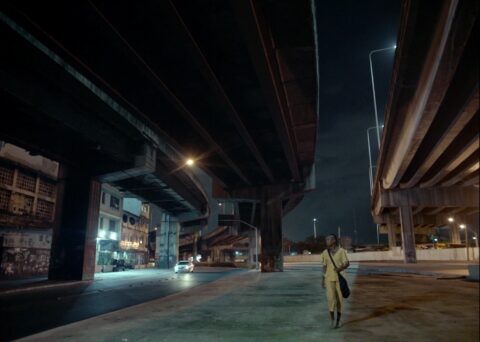In the title alone, Praia Formosa (Julia De Simone, 2024) foregrounds geography. The film’s wordless opening surveys industrial sites — devoid of people — within Rio de Janeiro’s Pequena África neighbourhood as metallic groans and liquid burbling tease the soundscape.
These translucent urban images signal an effaced legacy of brutal subjugation. Julia De Simone’s palimpsestic accentuation of the obscured histories which inform these sites is consonant with her documentary work while simultaneously anticipating the fertile creative ground she treads in her first fiction feature.
Muanza (Lucília Raimundo), a kidnapped slave from the 19th century Congo, circumnavigates the temporal and political restrictions enforced by aristocratic hegemony with steely resolve. Much of the film’s first half has her roaming the musty halls of the estate owned by Catarina Corte Real (Maria D’Aires). Muanza consistently subverts the authority of her mistress — in attitude and action — as she’s determined to escape her dilapidated confinement to find the symbolic sister, Kieza (Samira Carvalho), who helped her survive.
De Simone eschews suspense for austere portraiture by framing Muanza and Catarina in thresholds, like ghostly models for Manet’s Olympia (1863). The Sisyphean routine of an ageing matriarch bemoaning her absent husband gender-swaps the interminable purgatory of Diego de Zama. Yet, Praia Formosa deploys a modernist aesthetic in service of its heroine’s agency. Muanza’s fearless defiance of Catarina is merely the springboard for her greater transgression of historical constraints as she transports to the present in her quest to find Kieza.
For all its formal beauty, the incursion of local history provides Praia Formosa its urgency and structural discursiveness. The citations of Maria Firmina dos Reis and Pretextato dos Passos e Silva reify De Simone’s exercise in critical fabulation, imbuing the act of excavation with resonant implications in the wake of former president Bolsonaro’s campaign to whitewash the nation’s past. With its oceanic imagery and descriptions of terrestrial transformation, the film’s strongest throughline lies in its depiction of archaeology as a radical act, which arguably suits cinema better than any other medium.
Nick Kouhi is a programmer and critic based in Minneapolis, Minnesota
